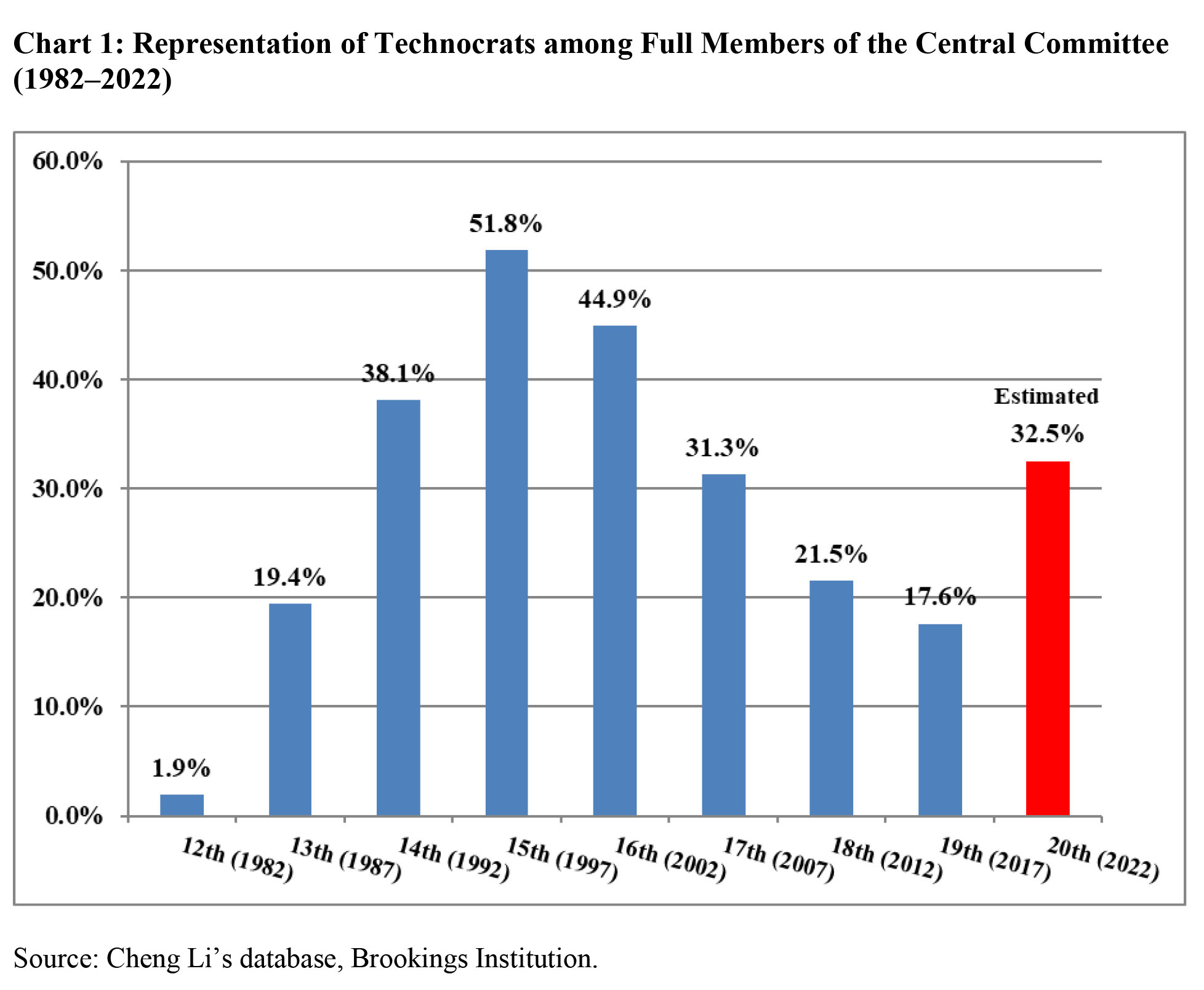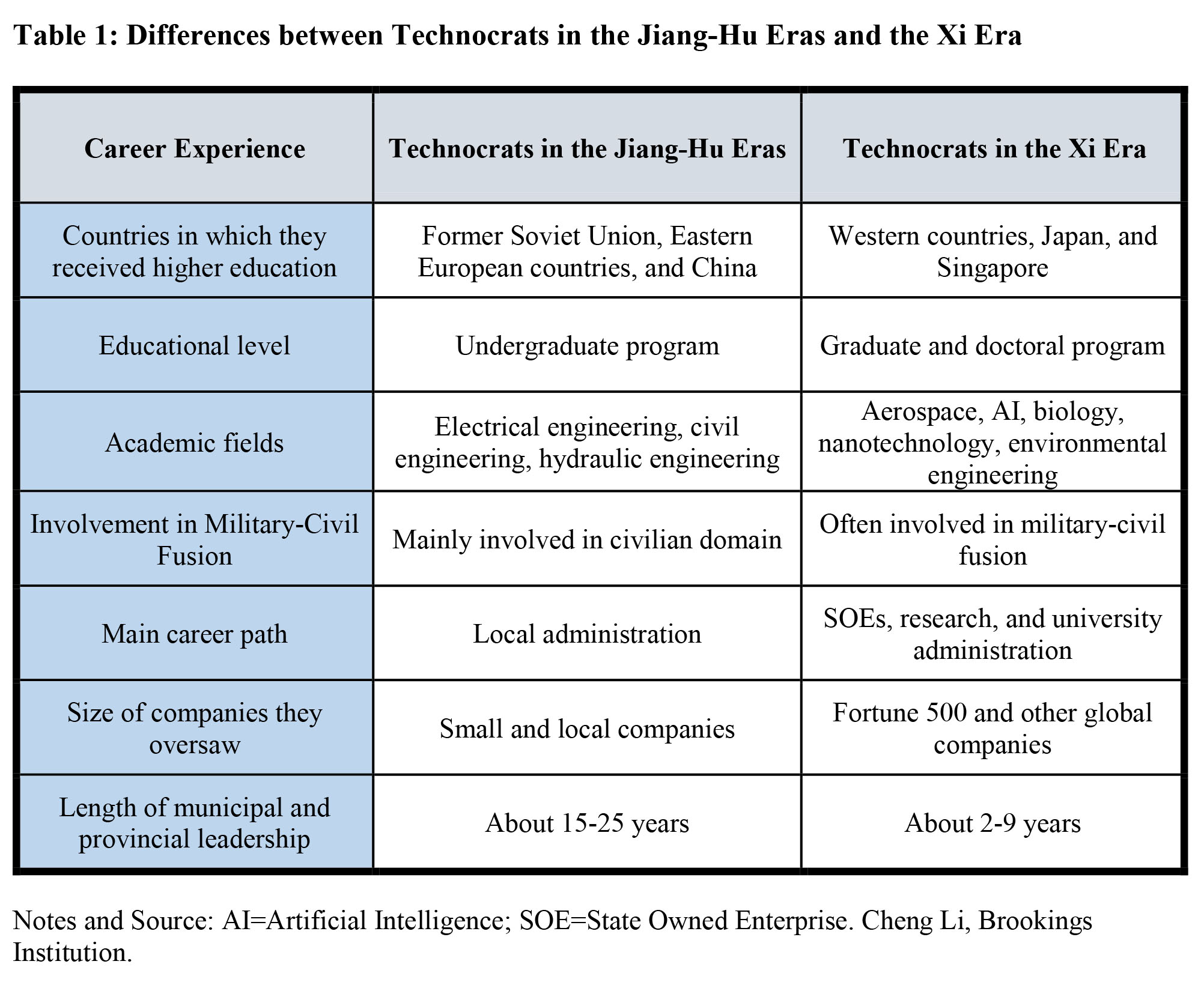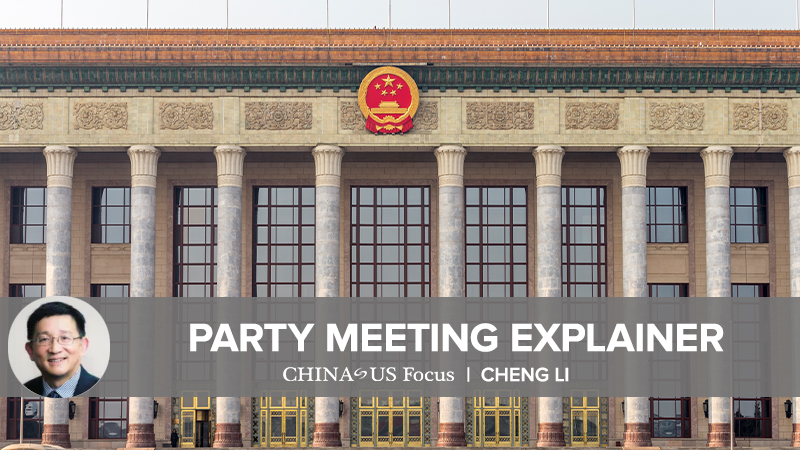During his seven-decade-long academic career, the distinguished British historian Joseph Needham tried to explain what Sinologists later called “the Needham paradox” or “the Needham question.” Paradoxically, although imperial China had many talented people and was advanced in science, the country started to decline around the 15th and 16th centuries. According to Needham, a primary reason for China’s decline was that the country had “lost its edge” by suppressing technicians and merchants. In contrast, these two elite groups were playing instrumental roles in the rapidly rising European powers of the time.
The conditions that Needham identified persisted in China through the 20th century, but the landscape underwent profound changes beginning in the mid-1990s. Following a decade-long effort in the Deng Xiaoping era to recruit engineers into the political leadership, these engineers-turned political elites, known as technocrats, dominated various levels of leadership in the Chinese Communist Party (CCP). This was particularly evident at the 15th Party Congress in 1997 and the 16th Party Congress in 2002. Members of the two Politburo Standing Committees formed during these two Congresses were all engineers by training.
Furthermore, the Chinese leadership codified in the CCP Constitution what was already true in practice — the enthusiastic recruitment of merchants, known as “entrepreneurs” by the Chinese. China’s business elites — both private entrepreneurs in firms of various sizes in the dynamic market economy and politically well-connected executives at state-owned enterprises (SOEs) — have been drivers of China’s economic rise on the world stage. In recent years, the Party leadership has embraced “common prosperity” and regulated gigantic private firms. But both the size of the private sector and the enormous influence of private business gurus such as Jack Ma, Robin Li, Pony Ma, and Jean Liu in present-day China would have been simply unimaginable two decades ago.
Understandably, both technocratic leaders and entrepreneurial elites in the country have experienced some important generational and other sociological changes within each group over the past two decades. Arguably the most far-reaching change lies in the transformation of Chinese technocratic leaders. A new cohort of technocratic elites, who can be referred to as “technocrats 2.0,” has rapidly risen to the national leadership. “Technocrats 2.0” often have expertise in information technology, nuclear technology, aerospace technology, shipbuilding, 5G, robotics, material science, life science, environmental science, and artificial intelligence. They have also spent many years –– and in most cases more than two decades –– serving as executives in China’s flagship SOEs and competing in the global market.
It is expected that this new group of technocrats will constitute a significant proportion of the 20th Central Committee formed this fall. As many as seven or eight members of this group will likely enter the new Politburo and will form an important elite group during Xi’s third term. To better forecast China’s policy trajectory on the economic and technological fronts in the next decade or so, students of the Chinese leadership must pay great attention to some defining characteristics of this rising elite cohort.
Defining the technocrats: Their rise and fall in the Jiang-Hu eras
The word “technocrat” does not have a universally accepted definition. Controversy may erupt as soon as the term is mentioned, as there are many diverse ideas about how it can or should be used. In the West, some scholars have portrayed technocrats as elites whose influence is based entirely or primarily on their technical expertise. Technocratic elites, according to these scholars, are nonpolitical or non-ideological. Some scholars use the term to differentiate technocrats from politicians –– technocrats are selected while politicians are elected. These notions in Western studies of technocrats obviously do not apply to the Chinese context. Even generally speaking, there is no need to exclude or mystify the political and ideological features of technocrats in any given country.
This study defines a technocrat as a person who concurrently holds specialized training in engineering or natural science, a professional occupation (for example, working as an engineer), and a leadership position. Strictly speaking, leaders who receive specialized training in the fields of economics and finance are not regarded as technocrats. In a broad sense, one may call these leaders “economic technocrats” or “financial technocrats,” terms that distinguish them from “technocrats” or “engineers-turned-technocrats.”
Very few Chinese leaders in the Party or government could be identified as technocrats at the beginning of the 1980s. In 1982, for example, only one minister in the State Council — the minister overseeing the Electric Power Industry, Li Peng, who later became premier and chair of the National People’s Congress (NPC) — was a technocrat, and no provincial Party secretaries or governors had a college level technical education. With the strong input of Deng Xiaoping, the 1980s–90s was a time of “technocratic turnover” within China’s Party-state leadership. At the turn of the century, 70 percent of ministers in the State Council, 74 percent of provincial party secretaries, and 77 percent of governors were technocrats.
Beginning with the 17th Party Congress that met in 2007, however, the dominance of technocrats in the Chinese leadership began to decline and the percentage of leaders with nontechnical educations started to rise sharply. The Politburo elected that year had 13 technocrats out of 25 members (52 percent), down from 18 out of 24 members (75 percent) in the 2002 Politburo. At the 18th Party Congress, only four members of the Politburo (16 percent) were technocrats. On the seven-member Politburo Standing Committee, only Yu Zhengsheng studied engineering and worked as an engineer during his early years.
This decline of technocrats in the Hu Jintao era was largely attributed to the fact that many of Hu’s proteges advanced their careers from the Chinese Communist Youth League (CCYL). Most of these officials with backgrounds in the CCYL leadership had often pursued university education in the fields of Party affairs, economic management, law, and humanities instead of engineering and natural sciences. Having leaders who are educated in a broader range of fields may well bring more diverse perspectives to policy making and problem-solving, especially when it comes to social issues and governance.
This trend continued in the formation of the leadership of the 19th Party Congress. In the 25-member Politburo formed in 2017, only two members (8 percent) could be considered technocrats: Xi’s chief-of-staff, Director of the General Office of the CCP Central Committee Ding Xuexiang (1962) and Secretary of the Central Political and Legal Committee Guo Shengkun (1954). Ding majored in the field of forging technology and equipment in the Department of Mechanical Engineering at Northeast Heavy Machinery College from 1978-1982, which was once affiliated with the Harbin Institute of Technology. After graduation, Ding went to Shanghai, where he worked at the Shanghai Institute of Materials Research for 17 years (1982-1999) before being promoted to deputy director of the Science and Technology Commission of the Shanghai municipal government. Ding also attended a postgraduate program on a part-time basis at Fudan University’s School of Management from 1989-1994 and received a master’s degree in science.
Guo majored in mineral processing in the Mining Department of Jiangxi University of Metallurgy from 1977-1979. He later also attended graduate programs on a part-time basis in the Department of Engineering and Management at both the Central South University of Technology (1994-1996) and Beijing University of Science and Technology (2003-2007). Guo spent 25 years of his professional career in the non-ferrous metal industry (1979-2004) and served as general manager and Party secretary of the Aluminum Corporation of China (2001-2004).
Both Ding and Guo hold the professional title of senior engineer. Ding is a leading candidate for a seat on the new Politburo Standing Committee at the 20th Party Congress and Guo is expected to retire this fall. Not a single current Politburo Standing Committee member is a technocrat. Although some members received a degree in engineering, they did not practice as an engineer and thus do not meet the definition of a technocrat.
Chart 1 shows the drastic change in the representation of technocrats among full members of the Central Committee (CC) of the CCP. In 1982, technocrats constituted just 2 percent of the CC, but by 1987 they made up almost 20 percent of the CC, and by 1997 they made up over half of the body. The representation of technocrats as full members of the CC then began to drop –– from about 44.9 percent in 2002 to 31.3 percent in 2007, 21.5 percent in 2012, and 17.6 percent in 2017.

Although China has witnessed a declining number of engineers-turned-officials at the national and provincial levels of leadership over the past two decades, the Xi administration began to nurture and promote a new cohort of technocrats, especially through the ranks of the country’s flagship SOEs, during the past decade. Based on the pool of candidates for full membership in the next Party Congress (those who currently serve as cabinet ministers, department heads of the major CCP organs, provincial Party secretaries and governors, and top military officers), this study estimates that there will be a resurgence of technocrats on the new CC this fall, constituting roughly 32.5 percent, higher than that of the previous three CCs. Most of them are the new type of “technocrats 2.0.”
Xi’s promotion of “technocrats 2.0”: How they differ from their predecessors
The rapid political ascent of a particular elite group in any given country is often linked to concurrent changes in domestic and international environments. The recent emergence of engineers/scientists-turned-political leaders in China’s Party-state with strong background in modern technologies is no exception. This phenomenon can also be attributed to the meteoric rise and the ever-increasing power of China’s large state-owned enterprises on the world stage.
Under the Xi administration, technically well-trained, politically trusted, business-savvy, and globally minded technocrats have increasingly been viewed as suitable candidates for the CCP leadership, thus these new recruits differ profoundly from their old-fashioned technocratic predecessors. Table 1 shows the major differences in terms of career experience between technocrats in the Jiang-Hu eras and the Xi era.

Due to historical circumstances, a significant number of Jiang Zemin’s generation of technocrats received their education or technical training in the former Soviet Union and other Eastern European socialist countries in the 1950s. They included a number of members of the Politburo Standing Committee: Jiang Zemin (Soviet Union), Li Peng (Soviet Union), Luo Gan (East Germany), Li Lanqing (Soviet Union), and Wei Jianxing (Soviet Union). Almost all of Hu Jintao’s generation of technocrats were trained domestically in Chinese universities in the 1960s prior to the Cultural Revolution. Members of both Jiang’s generation and Hu’s generation usually only attended undergraduate programs.
The academic fields that they studied were overwhelmingly focused on electrical engineering, civil engineering, and hydraulic engineering. This was particularly evident among the top three leaders in both the Jiang era and the Hu era: General Secretary Jiang Zemin (electrical engineer), NPC Chair Li Peng (hydroelectric engineer), and Premier Zhu Rongji (electrical engineer) in the Jiang administration; and General Secretary Hu Jintao (hydraulic engineer), NPC Chair Wu Bangguo (electrical engineer), and Premier Wen Jiabao (geological engineer) in the Hu era. In the Jiang-Hu eras, senior officials often came from the fields of petroleum, hydroelectric engineering, and geology. In the Xi era, the development of traditional mass production industries had to take a back seat, shifting “toward new science-based industries like artificial intelligence, aerospace technology, and telecommunications,” including high-tech manufacturing represented by the military industry.
In these new circumstances, many prominent “technocrats 2.0” in the Xi administration studied aeronautics and astronautics, as discussed in one of the previous articles on the “cosmos club” in this series. They include Xinjiang Party Secretary Ma Xingrui (1959), Hunan Party Secretary Zhang Qingwei (1961), Zhejiang Party Secretary Yuan Jiajun (1962), newly appointed Minister of Industry and Information Technology Jin Zhuanglong (1964), and Minister of the State-owned Assets Supervision and Administration Commission Hao Peng (1960).
A few other rising stars in the Chinese leadership also majored in critically important scientific and technological fields. Shandong Party Secretary Li Ganjie (1964) received both his undergraduate and graduate degrees in the field of nuclear reactor engineering in the Department of Engineering Physics at Tsinghua University. He also served as director of the National Nuclear Safety Administration of the PRC. Beijing Mayor Chen Jining (1964) received both his bachelor’s and master’s degrees in Environmental Engineering at Tsinghua University. He served as minister of Environmental Protection for two years before being appointed as mayor of the capital city in 2017.
Liaoning Party Secretary Zhang Guoqing (1964) and Shaanxi Party Secretary Liu Guozhong (1962) both majored in military technology as undergraduates. In Liu’s case, he majored in design and manufacture of shell-triggered fuze. Many leaders from the “technocrats 2.0” cohort have engaged in Xi’s drive to promote military-civil fusion, as the previous two articles of this series explained.
Almost all of the “technocrats 2.0” cohort received graduate degrees, and many hold a doctoral degree. Many also had foreign study or work experience. For example, Chen Jining lived in the United Kingdom for ten years (1988-1998) during which he received his Ph.D. in environmental systems analysis at Imperial College and worked as a post-doctoral/research fellow in the same school. Li Ganjie studied at the French Institute of Nuclear Safety and Radiation Protection from 1991-1992 and worked as First Secretary in the Science and Technology Division of the PRC Embassy in France from 1999-2000. Zhang Qingwei studied at the Japan International Space University in 1992. Yuan Jiajun was a visiting research fellow at the Institute of Mechanical Mechanics of the German Academy of Aeronautics and Astronautics from 1989-90.
Another major difference between technocrats in the Jiang-Hu eras and the Xi era lies in their main career paths. Previous generations of technocratic leaders such as Jiang Zemin, Zhu Rongji, Hu Jintao, Wu Bangguo, Jia Qinglin, and Yu Zhengsheng all advanced their careers primarily from local administration, and their tenures as municipal and provincial leaders usually lasted for 15-25 years. Some might have served as managers of SOEs, but they had usually worked for small and local enterprises for a few years.
In contrast, many “technocrats 2.0” have advanced in their professional and political careers by serving as business executives in China’s flagship SOEs, many of which are Fortune 500 companies or other global enterprises. Ma Xingrui, Zhang Qingwei, Yuan Jiajun, Zhang Guoqing, Jin Zhuanglong, and Hao Peng have all had substantial leadership experience as top business executives. Most of them also served as municipal and provincial chiefs, but their tenure in local leadership ranged between two to nine years, much shorter than their peers in the previous generation of technocrats.
These features of the “technocrats 2.0” cohort are important as they move to center stage of the national leadership at the upcoming Party congress. As Chen Gang, a researcher at the East Asian Institute of the National University of Singapore recently observed, these rocket scientists- or AI experts-turned technocratic leaders may “reinforce their belief in the crucial role of applied science and technology in determining regime strength and economic competitiveness.”
The next article in this series will further examine the growing representation of university administrators and top scientists in the Xi leadership, a topic that has largely been overlooked in Pekingology today.

